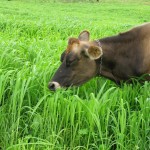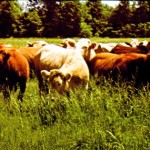Is It Time to Re-Consider Our Forage Base?
Larry A. Redmon
State Forage Specialist, Texas AgriLife Extension Service College Station
Input costs associated with owning grazing livestock, whether cattle, sheep, or goats, have increased significantly over the past several years, so much so that many livestock producers are currently asking themselves “How much longer can I remain in the business?”
It’s a fair question.
The answer, as in most cases, is… it depends. It depends first of all on what the forage base is, and secondly, whether or not raising livestock is the sole source of income for the producer. If the forage base is a low-input grass such as bahiagrass in the eastern part of the state, or native forages on the rangelands, then the enterprise is already well-positioned for the increased (and increasing!) cost of fertilizer nutrients. Regarding the income derived from livestock production, for many producers profit is not the primary motive for raising livestock. For these part-time producers, in many cases the following items may be of more importance than realizing a profit:
- Maintaining an agricultural property tax exemption. Reduced property taxes may actually be the profit in part-time livestock production.
- Being able to provide a Schedule F with their income tax return to reduce the amount of tax they are liable for. Again, reduced income taxes, as in the case of reduced property taxes may be the profit in the enterprise.
- Simply enjoying the life style associated with owning livestock.
- Having a place to raise/take the children and grandchildren.
If the part-time livestock producer currently has an introduced forage requiring significant fertilizer inputs, such as bermudagrass, the economics associated with appropriate fertilizer to  maintain the stand may no longer be economically justifiable. It is well-known that if bermudagrass is not well-fertilized the stand will eventually decline. Thus, part-time livestock producers may wish to re-consider their forage base. In other words, bermudagrass may no longer be the best choice for the part-time livestock production enterprise and it may be time to consider a transition to native forages.
maintain the stand may no longer be economically justifiable. It is well-known that if bermudagrass is not well-fertilized the stand will eventually decline. Thus, part-time livestock producers may wish to re-consider their forage base. In other words, bermudagrass may no longer be the best choice for the part-time livestock production enterprise and it may be time to consider a transition to native forages.
If the primary reasons for owning livestock include 1-4 above, a native forage resource base can accomplish all of the ultimate goals at a much reduced level of inputs when measured in either dollars or time. Consider the following benefits to using a native forage resource base for producing livestock.
- Native forages provide good nutrition for grazing livestock.
- Native forages do not require fertilizer inputs as do introduced forages
- Native forages are drought and cold tolerant.
- Native forages do not require the same level of time commitment as do introduced forages (planning for fertilizer, herbicide inputs, hay baling, etc.,).
- Native forages provide enhanced wildlife habitat compared with introduced forages.
There is no free lunch, as they say, and the transition to native forages comes at the following costs:
- Stocking rates will be reduced compared with well-fertilized introduced forages.
- You will not generally harvest hay from native forages.
- Native forages are expensive to establish.
- Native forages may be slow to establish compared with introduced forages.
- Native forages will likely need to be rotationally stocked to allow for appropriate residue height management to necessary to maintain the stand.
If the decision is made to transition from introduced forages to native forages, the following establishment strategies should be considered.
- Plan at least one year in advance of the establishment date.
- Destroy all existing perennial grass vegetation with glyphosate during the late summer or early autumn the year before the native forages are to be established.
- Prepare an excellent seedbed to minimize competition for the native forage seedlings.
- Plant seed at the appropriate rate and depth.
- Follow through with appropriate weed management strategies.
- Graze lightly the establishment year, if at all, and appropriately thereafter.
- Do not harvest native forages for hay.
To minimize transition costs, producers should consider a gradual phase-in of the native forages over time. That is, consider establishing 10-20% of the property per year. This will spread the risk associated with establishment, reduce the capital outlay for establishment in any one year, and eliminate the need for complete de-stocking of livestock during the deferment period.
Producers transitioning to native forages should realize native forages developed under a system of nutrient cycling where the soil nutrient status was in equilibrium with the forage produced.
Therefore, native forages cannot successfully be established and maintained on a piece of property that has been subject to long-term abuse. If a soil analysis indicates a need for fertilizer nutrients, then appropriate fertilizer inputs will be initially required for establishment. As the forages become established, re-introduce grazing slowly to determine what level of stocking rate will be appropriate for your new forage base. DO NOT OVERSTOCK!
The choice of native forages are many, but for most of Central Texas the best choices may include big bluestem, little bluestem, yellow indiangrass, switchgrass, sideoats grama (state grass of Texas), and eastern gamagrass. Five of the six species listed are considered tall grass species and should not be grazed shorter than approximately 10” in height. Sideoats grama should not be grazed shorter than 4-6” in height. Maintaining these residues heights is important in maximizing persistence of the species. This residue height management will likely require that animals be rotationally stocked to allow forages to recover from grazing events.
As indicated earlier native forages provide much better wildlife habitat than do the monocultures of introduced forages. For many landowners, this in itself may be sufficient justification to restoring the native forages to the landscape. Native forages are also aesthetically pleasing to the eye and there is something about restoring the native prairie that has great appeal to many landowners.
Native forages may not be appropriate for all part-time livestock producers. Given the economic constraints that are being imposed due to historically high fertilizer costs, however, the transition back to native forages may be an idea whose time has come for many. It is like the old saying “having your cake and eating it too…” native forages can provide all of the benefits with few of the liabilities and help keep part-time livestock production an enjoyable enterprise.
